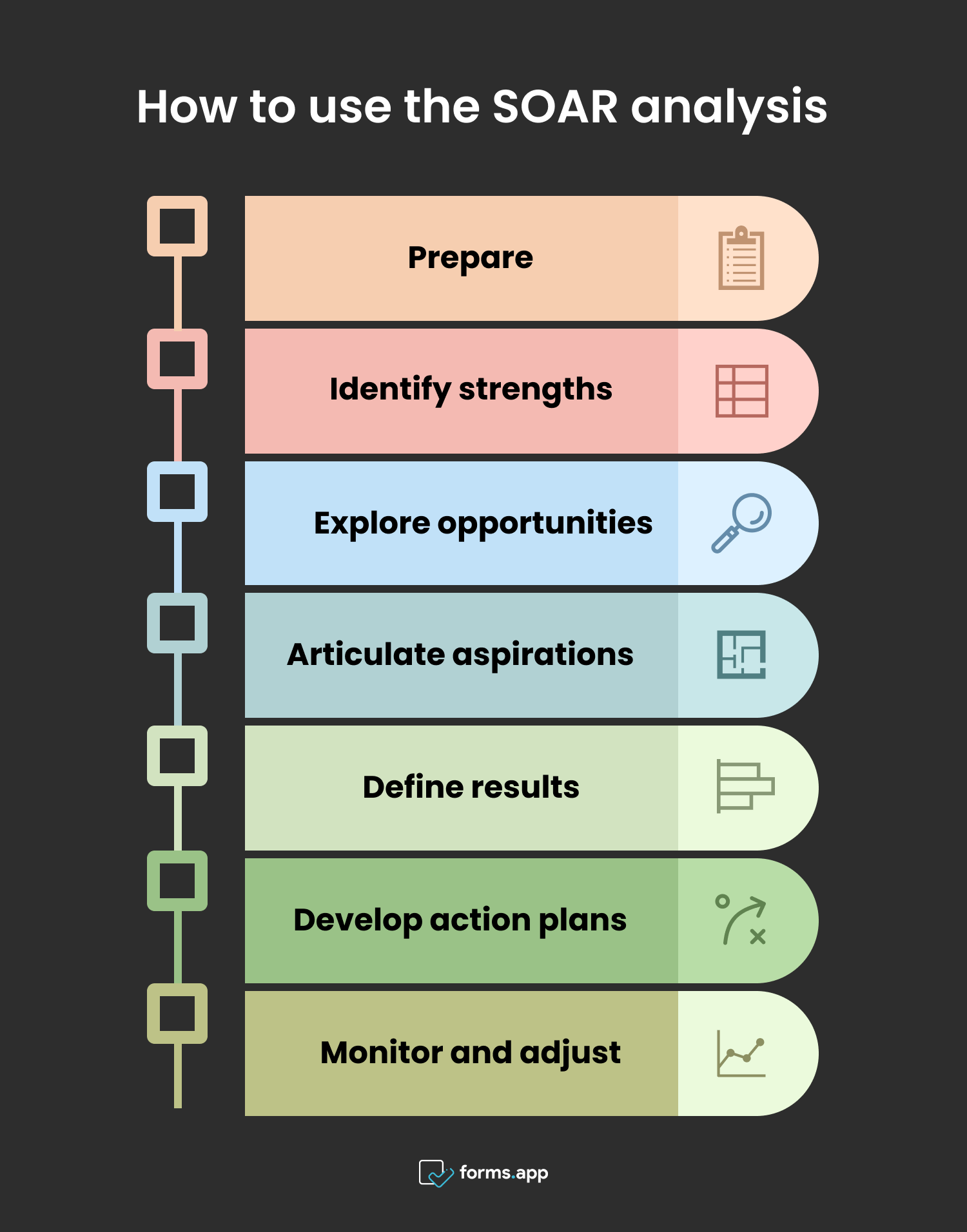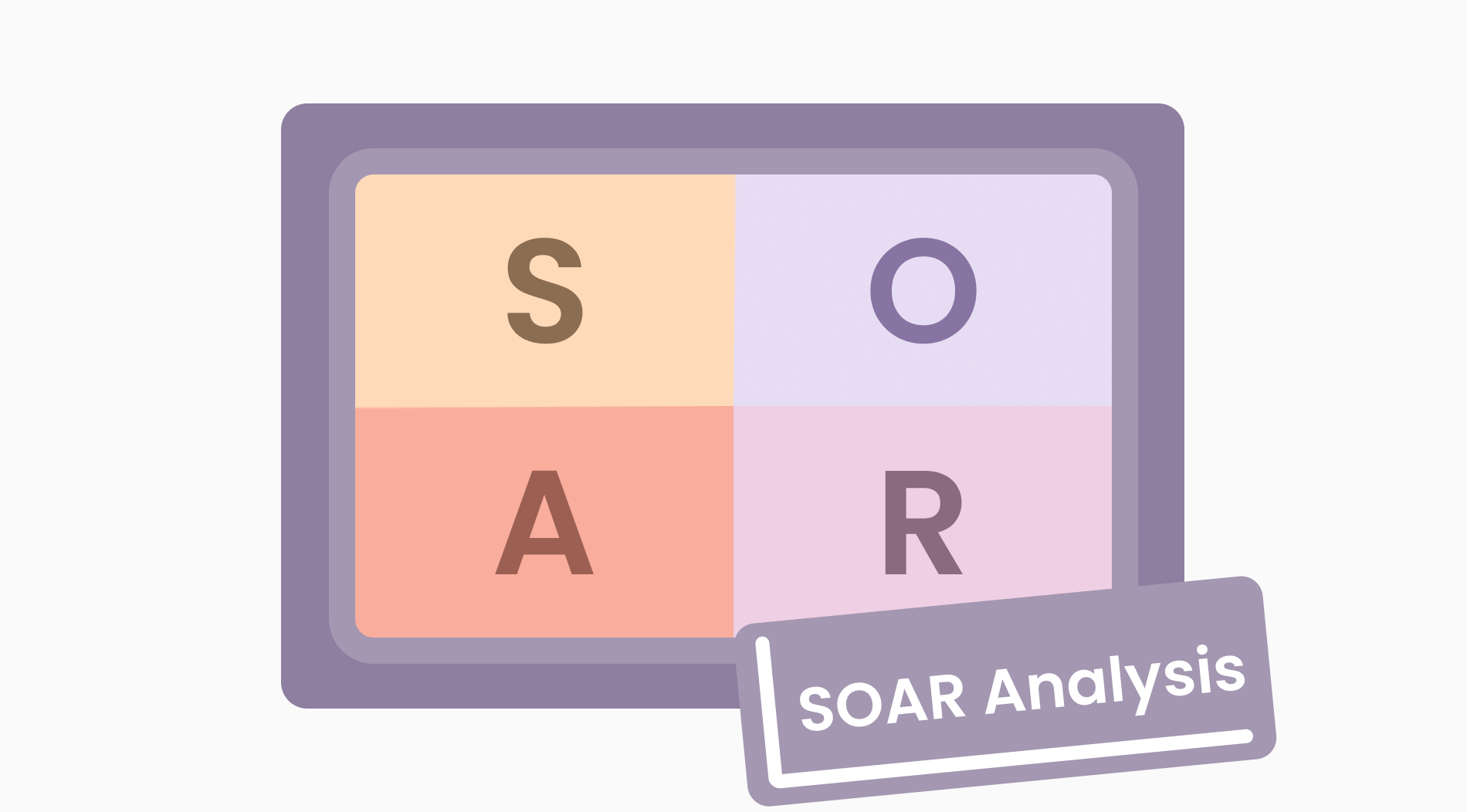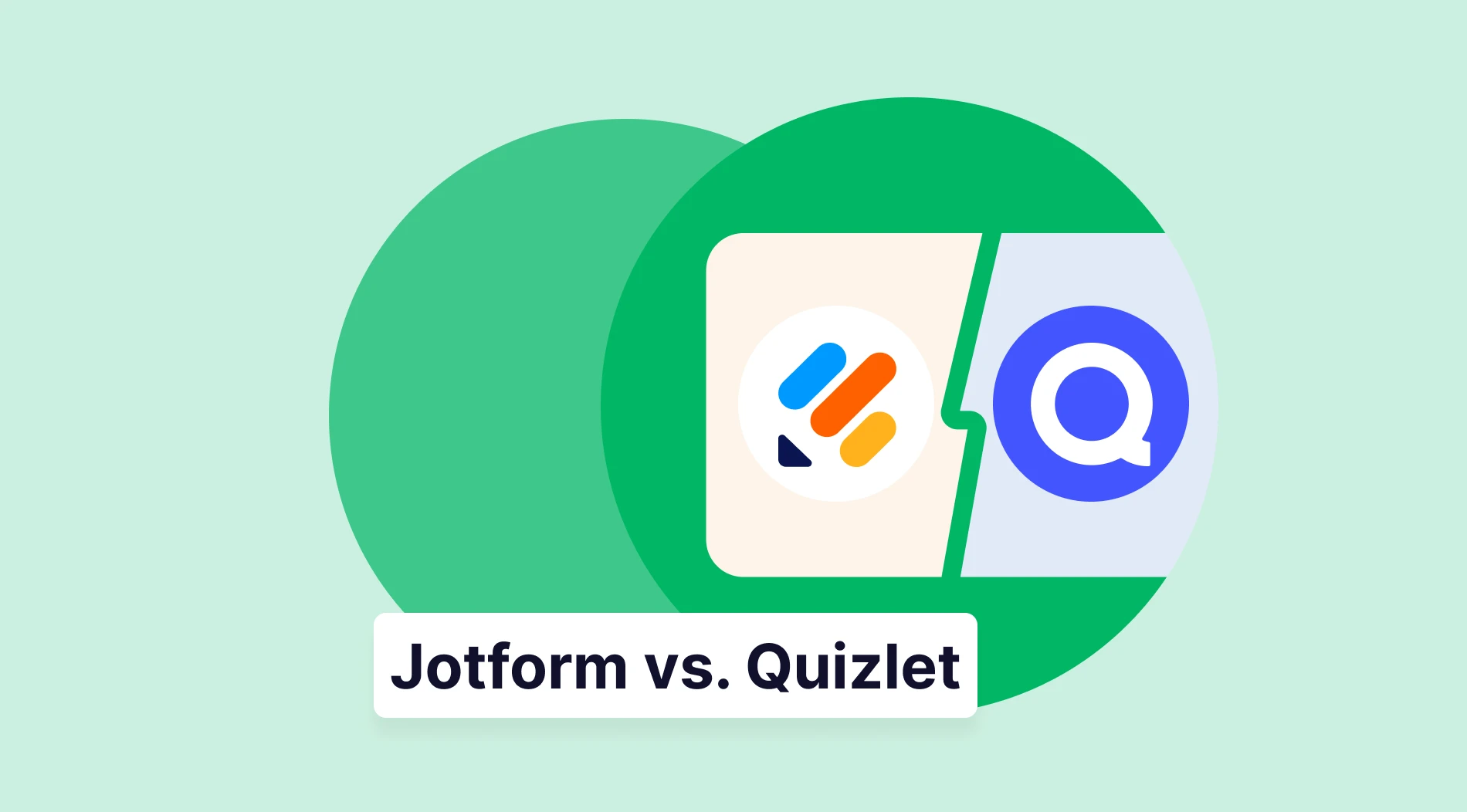In the dynamic landscape of strategic planning and decision-making, companies and organizations may search for methods to assess their current positions and develop strategic goals for future success. Many tools and methodologies are available. However, one stands out in its forward-thinking aspects and comprehensive framework: the SOAR analysis.
This article will serve as a comprehensive guide for you if you consider using the SOAR analysis. We will also discuss suitable environments, the steps to take, and the model’s advantages and disadvantages. We will also touch upon the most frequently asked questions about the subject that will answer any questions you might have about the model.
What is the SOAR analysis?
SOAR analysis is a strategic planning tool that focuses on an organization’s positive attributes and future potential. The acronym stands for Strengths, Opportunities, Aspirations, and Results.
It is relatively similar to the famous SWOT analysis, which also considers weaknesses and threats. However, SOAR emphasizes leveraging strengths and opportunities to achieve desired outcomes.
It is a forward-thinking approach to strategic project planning that emphasizes strengths, opportunities, aspirations, and results. You can highlight its positive attributes and align its efforts with a long-term vision. Your company can drive growth, innovation, and success in today’s dynamic business environment. Now, let’s delve into the acronym SOAR and see the model in more detail:

The SOAR analysis
1- Strengths
This component of the SOAR analysis involves identifying and leveraging the organization’s core strengths, assets, capabilities, and resources. Strengths may include internal strengths and external factors such as a strong brand reputation, a talented workforce, and innovative products or services. It may also entail robust infrastructure, financial stability, and a loyal customer base. Focus on the positives!
If you want to identify and add to your company’s strengths, recognize your core competencies. These include expertise in a particular technology or exceptional customer service. You may also need to assess the allocation of your sources and how to optimize them to maximize performance and achieve strategic objectives. Keep your eye on your strengths, weaknesses, and opportunities.
2- Opportunities
In this step, the companies can explore external factors and identify emerging trends, market opportunities, and areas for growth. Opportunities may arise from changes in technology, industry dynamics, market demands as well as regulatory shifts, or demographic trends. Companies can expand their market presence, increase revenue, and gain a competitive edge.
If you want your company to grow, you always need to keep your eyes open, identifying opportunities. Doing market analysis, gaining industry insights, and monitoring the environment will enable you to leverage opportunities. By considering geopolitical developments and societal trends, you can create opportunities for growth and innovation. Do not overlook weaknesses, opportunities, and threats.
3- Aspirations
Aspirations represent the organization’s vision for the future and its desired outcomes. This component involves articulating long-term goals and aspirations. Aspirations inspire and motivate relevant stakeholders.
They guide their efforts and decisions toward achieving the organization’s desired future potential. Aspirations may include goals such as market leadership, innovation excellence, sustainability, social impact, or customer satisfaction.
Your company can always benefit from your aspirations, and strategic planning processes are important for this. You need to have visionary leadership and foster a culture that inspires. You also need to set specific and realistic goals for the future.
Break down long-term aspirations into short-term objectives. Prepare action plans to make progress, trackability, and accountability easier. Your future aspirations matter!
4- Results
This section of the SOAR focuses on defining key performance indicators (KPIs) and metrics. These help you measure progress toward achieving aspirations and desired outcomes. Results provide a tangible framework for assessing the effectiveness of strategies and initiatives. By setting clear and measurable goals, companies can track their performance and identify areas for improvement.
The last step of SOAR analysis enables your company to have measurable results. You can implement systems and processes to track and monitor performance against the established KPIs regularly. Analyzing data and performance trends will enable you to identify areas of strength as well as areas for improvement. By taking feedback and adapting strategies based on these, you can ensure continuous improvement.
When to use the SOAR analysis
SOAR analysis is a versatile tool applied to various organizational contexts to foster strategic thinking and drive positive organizational change. It empowers organizations to leverage their strengths, seize opportunities, and achieve their desired outcomes in today’s dynamic and competitive business environment. It can be particularly beneficial for the following:

Right times to use the SOAR analysis
- Strategic planning: Use SOAR analysis during strategic planning processes to assess the organization’s current state and identify strategic priorities. Follow a course for future growth and success.
- Organizational change: Implement SOAR analysis during organizational changes, such as mergers, acquisitions, or restructuring. It enables stakeholders to identify opportunities.
- Innovation initiatives: SOAR analysis can be beneficial when launching innovation initiatives or exploring new market opportunities. It helps organizations capitalize on their core competencies and explore emerging trends.
- Performance improvement: Utilize SOAR analysis to assess performance, identify areas of strength, and uncover opportunities for improvement. Focus on positive attributes and future potential.
- Employee engagement: Engage employees in SOAR analysis to foster a sense of ownership, collaboration, and commitment to organizational goals. Involve your employees in the process and cultivate a positive work environment.
How to use the SOAR analysis
If you want to use SOAR analysis effectively, we have some steps to follow. You can leverage strengths, seize opportunities, and achieve your desired outcomes. You can do so in a proactive and strategic manner by taking these steps:

Steps to use the SOAR analysis
- Prepare: Gather relevant stakeholders, including leaders, managers, and key employees, to participate in the analysis. Ensure everyone understands the purpose, objectives, and process of SOAR analysis.
- Identify strengths: Set up brainstorming sessions to identify and list your company’s core strengths, assets, and capabilities. Encourage participants to reflect on what the company does well.
- Explore opportunities: Conduct a thorough assessment of the external environment to identify emerging trends, market opportunities, and areas for growth. Analyze industry dynamics, market research, and customer insights.
- Articulate aspirations: Engage stakeholders in planning the organization’s future state by articulating aspirations, goals, and desired outcomes. Encourage participants to think creatively and ambitiously.
- Define results: Determine key performance indicators (KPIs) and metrics to measure progress towards achieving aspirations and desired outcomes. Define clear and measurable goals.
- Develop action plans: Based on the insights gained from the analysis, develop action plans and strategies. Leverage strengths, capitalize on opportunities, and achieve desired results.
- Monitor and adjust: Continuously monitor progress against established goals and KPIs. Review and adjust strategies as needed based on your performance data, feedback, and changing market dynamics.
Advantages & Disadvantages of the SOAR analysis
The SOAR analysis offers several benefits for organizations to identify and grow their potential. However, it has some disadvantages. The companies should be mindful of their limitations and ensure a balanced approach and strategic planning. Here are its advantages and disadvantages:
Advantage 1- Positive Focus: Engagement and Collaboration
SOAR analysis emphasizes strengths, opportunities, aspirations, and results. It fosters a positive and proactive approach to strategic planning. It also encourages stakeholder engagement and collaboration. The analysis promotes buy-in and ownership of organizational goals by facilitating active participation and collaboration in strategic planning processes.
Advantage 2 - Alignment with Aspirations: Innovation and Creativity
SOAR aligns organizational efforts with long-term aspirations. It guides decision-making towards desired outcomes and collective goals. It also encourages the exploration of opportunities and aspirations. SOAR analysis stimulates innovation and creativity in an organization, driving it to envision and pursue future success.
Disadvantage 1 - Overlooking Weaknesses and Threats: Subjectivity and Ambiguity
The exclusive focus on strengths and opportunities may result in overlooking weaknesses and threats, potentially leaving an organization vulnerable to unforeseen challenges. Furthermore, the subjective nature of aspirations and results may introduce ambiguity, which may lead to challenges in defining clear and actionable goals and objectives.
Disadvantage 2 - High Level of Engagement: Lack of Structured Framework
Conducting a thorough SOAR analysis demands significant engagement and commitment from stakeholders. It may be difficult to achieve consistently. Also, the absence of structured frameworks and guidelines for SOAR analysis poses a challenge.
It may lead to inconsistencies in its application across different organizational contexts. These may limit the effectiveness and reliability of the SOAR analysis.
Example of the SOAR Analysis
So far, we have covered the SOAR analysis with many of its aspects. These aspects include its suitable environments, which steps to take as well as its advantages and disadvantages. A SOAR analysis template may include a page of 4 columns. These columns can list Strengths, Opportunities, Aspirations, and Results.
Now, to understand the SOAR analysis better, let’s see it in a concrete example. We will use the SOAR analysis in a hypothetical scenario. This scenario will involve a famous and huge company using the model and achieving successful results. Here it is:
IKEA
IKEA, a global leader in furniture retail, decides to conduct a SOAR analysis. They want to improve its strategic planning efforts and drive future growth. Firstly, IKEA identifies its core strengths. These strengths include a strong brand reputation for affordable and stylish furniture, as well as a global network of stores and efficient supply chain management.
Secondly, through market research and trend analysis, IKEA identifies several opportunities for growth, including expanding into emerging markets and leveraging e-commerce. IKEA articulates its aspirations to become the leading provider of affordable and sustainable home furnishings globally. The company aims to enhance customer satisfaction and drive innovation in product design.
IKEA defines key performance indicators (KPIs) within team members. They measure progress toward their aspirations and the results, such as revenue growth and market share expansion. By tracking these and adjusting strategies, IKEA achieves positive outcomes, including increased sales, market penetration, and brand loyalty. IKEA is now more successful and competitive in the furniture retail market.
Frequently asked questions about the SOAR analysis
The SOAR analysis comprises four key components: Strengths, Opportunities, Aspiration, and Results. It involves recognizing and leveraging the unique strengths of a diverse workforce, identifying opportunities for growth and innovation through diversity, and setting ambitious aspirations for inclusion. It also includes measuring the outcomes and impact of diversity initiatives to drive organizational success and create a more inclusive workplace culture.
The SOAR analysis primarily focuses on internal factors within an organization, such as strengths, opportunities, aspirations, and results. It may consider some external factors, such as market opportunities or industry trends. However, its primary objective is to assess and leverage internal resources and capabilities. It aims to achieve strategic goals and desired outcomes.
SWOT and SOAR analyses are strategic planning tools that differ in focus and approach. SWOT evaluates internal (strengths and weaknesses) and external (opportunities and threats), aiding in risk assessment and decision-making. However, SOAR emphasizes internal factors such as strengths, opportunities, aspirations, and results.
To write a SOAR analysis, you need to gather stakeholders and materials, define objectives, and identify strengths. You can explore external opportunities through market research and articulate aspirations by setting ambitious goals and a clear vision. Also, you can define key performance indicators, foster collaboration, and develop actionable strategies. Ensure continuously monitoring your progress and adjusting strategies as needed.
Final words
In conclusion, the SOAR analysis offers organizations a strengths-based approach to strategic planning, emphasizing positive attributes and future-oriented strategies. By leveraging strengths, capitalizing on opportunities, and setting ambitious aspirations, organizations can drive innovation, foster collaboration, and achieve their desired outcomes.
In this article, we have covered the SOAR analysis in detail and mentioned when/how to use it. We have discussed its advantages and disadvantages. Also, we have seen a SOAR analysis example, a scenario of a large corporation. Last but not least, we have answered some of the most frequently asked questions about this subject.
You have learned about the SOAR analysis; it’s time to use it in your business today!
Fatih is a content writer at forms.app and a translator specializing in many text domains, including medical, legal, and technical. He loves studying foreign languages. Fatih especially likes to create content about program management, organizational models, and planning tools.



